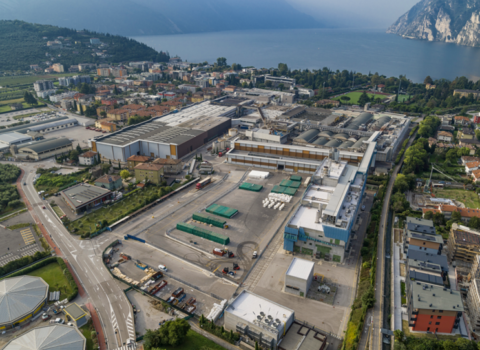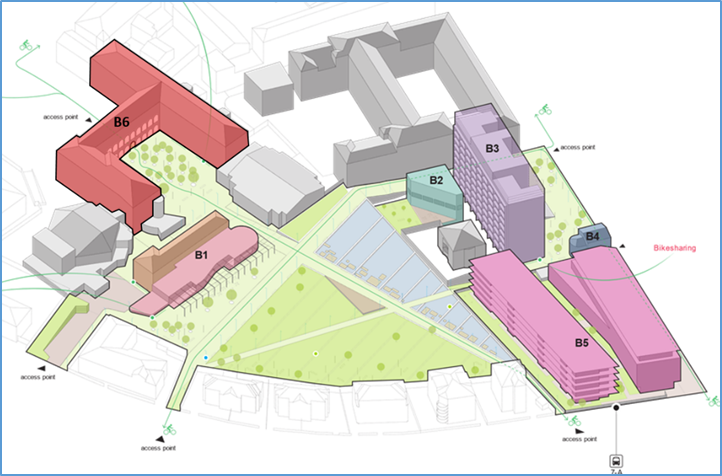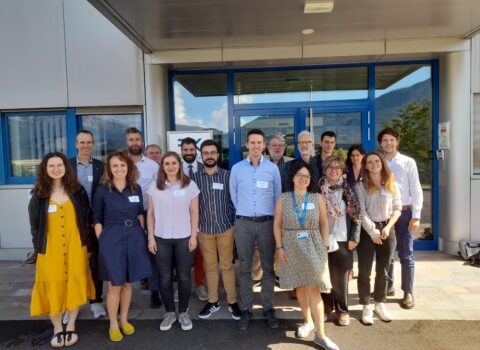
The redevelopment of the Santa Chiara Cultural Services Center in Trento to start: FBK main player with InCUBE
FBK is leading a major European project in the building sector, aimed at ensuring innovative activities in terms of energy efficiency, integration of renewable sources and models/tools for digitization.
The InCUBE project plans to support the energy upgrading of buildings through standardized and integrated state-of-the-art processes based on 4 key pillars for innovation: (i) industrialization (off-site production solutions, including the use of robots), (ii) new technologies for the production and storage of energy from renewable sources, as well as environmentally friendly products and materials, (iii) digitization (dynamic Digital Twins of products and buildings), and (iv) new market players, organized according to new business models.
In Trento, the Santa Chiara district represents one of the 3 European demonstrator sites, supported not only by the City of Trento but also by FBK (with the Center for Sustainable Energy – Sustainable Territories Area, and the Center for Digital Industry – 3DOM and DSIP Units) as well as innovative companies in the building, energy and digital fields.
“After a lengthy design and tender phase, works at the Santa Chiara Cultural Services Center started in February 2025 with the erection of the crane and scaffolding,” Diego Viesi, Senior Researcher & Advisor of the Sustainable Territories Area, pointed out. “Thanks also to FBK’s contribution with InCUBE, the building complex will have a new insulated roof, the integration of renewable sources such as a new geothermal heat pump system (shared with the former cafeteria) and a new photovoltaic tile system (on the roof of the Palabocchi sports hall), sensors for monitoring indoor environmental quality (temperature, humidity, CO2) and sensors for energy monitoring (consumption and production). In addition, innovative solutions for monitoring site safety and environmental impacts will be tested during the redevelopment work. ”
“Over the past 4 years, through its Sustainable Territories Area, the Center for Sustainable Energy has been particularly active in involving many communities and actors in the Trentino context,” Viesi went on. “In fact, 9 European projects with local demonstrators have been acquired, for a direct impact in the Province of Trento alone of about 10 million euros in a variety of areas: (i) construction with InCUBE (Trento), (ii) industry with FLEXIndustries (Rovereto), USES4HEAT (Riva del Garda) and LEONARDO (Storo, starting in September 2025), (iii) energy communities with ECOEMPOWER (Trentino), COMMUNITAS (Valle di Primiero) and CELINE (Alpe Cimbra), (iiii) climate change with NEVERMORE (Trentino), and (iiiii) hydrogen with AMETHYST (Trentino). ”

The context
The city of Trento is facing a period of major urban transformation, including the rail bypass and multiple PNRR projects. Steps for intense urban regeneration have been initiated by the City of Trento since the early 2000s, together with the Province of Trento and local financial support. During this period, the regeneration of the Santa Chiara neighborhood, adjacent to Piazza Fiera, was initiated. Despite its centrality, starting in the 1980s, the neighborhood lost importance and was gradually abandoned as the functions located there were transferred to other areas of the city (Crispi Schools, Nursing Home, Redeemer Church). At the same time, the so-called “Buco Tosolini” remained as a bulky void devoid of functionality. Certainly, a jarring contrast to the touristy Piazza Fiera and a number of neighboring amenities of great public value and essential to the city such as the Santa Chiara Auditorium, the Cuminetti Theater, the Palabocchi Sports Hall and the public park, one of the main and most popular urban parks.
The redevelopment of the Santa Chiara neighborhood began with the Crispi Schools works, an investment of 27 million euros in the period 2001-2014 for the expansion of the school area, the establishment of the music schools and the Conservatory, and new buildings such as an auditorium, gymnasium and cafeteria.
A further turning point came in 2016 with the “Bando Periferie,” a national grant of 18 million euros that enabled a series of additional construction sites, some completed and others under construction (until 2026), surrounding Santa Chiara Park. Among these public interventions we have (i) the renovation of the former nursing home that would become the new headquarters for the municipal technical offices, (ii) the recovery of the former cafeteria to build the new buildings of the Engineering and Architecture Schools, the Urban Center and the youth center, (iii) the renovation of the former Trento Civica Nursing Home offices building, (iv) the restoration of the Little Church of the Redeemer, and (v) the redevelopment of the open spaces and connective tissue of the Santa Chiara district. Then there is an important private investment in the area of the “Buco Tosolini” empty area for the construction of the Habitat Complex (an additional 23 million euros as an initial amount).
The latest step came through the new redevelopment project of the Former College of Liberal Arts (Santa Chiara Cultural Services Center), worth about 9 million euros, to which PNRR funding (1 million euros) was then added for the Santa Chiara Auditorium and the Cuminetti Theater. The building complex is divided into several building bodies that, built in different periods, contribute to determine its current appearance. The main part, represented by the historically oldest core, originated in the first half of the 12th century as the monastery of St. Clare adjacent to the church of St. Michael the Archangel. From the historical-artistic point of view, the building is partly protected by direct bond and partly subject to indirect protection. Various changes of use and even heavy interventions of renovation and reconstruction led to the current architectural appearance and the inauguration, in 1985, of the structure as we know it today, complete with the two new structures for the auditorium and the gymnasium.
In this latter context, FBK introduced the In CUBE European Horizon Europe project, launched as early as 2022, allocating about 2 million euros for the innovative activities listed above (energy efficiency, integration of renewable sources and models/tools for digitization).






